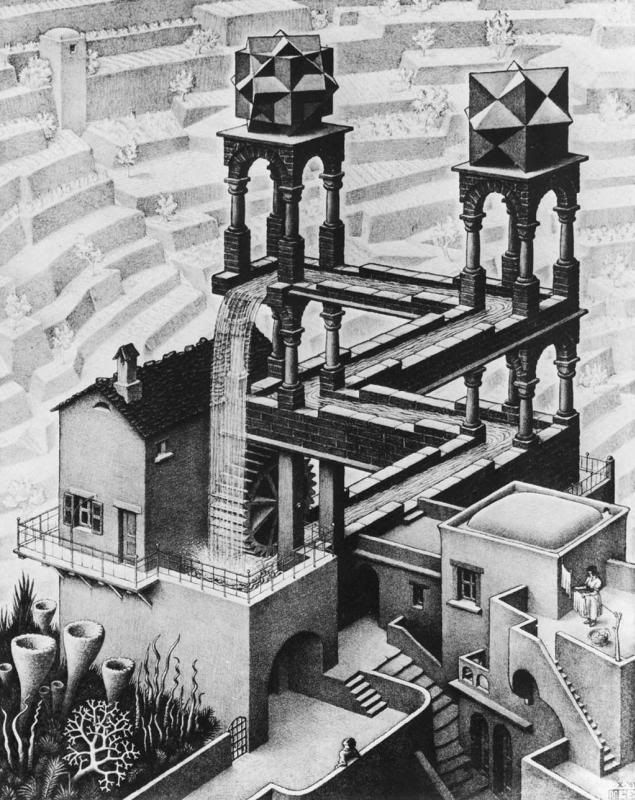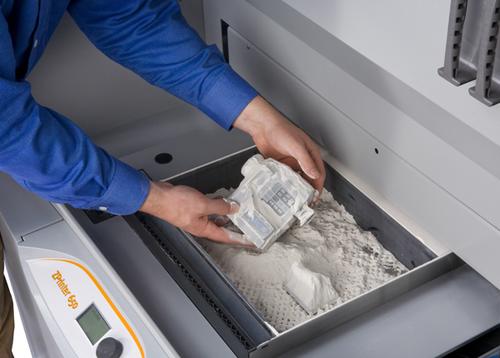
Posted on 12/16/2013 4:14:55 PM PST by 2ndDivisionVet
Building on the Moon, 4D printing, self-repairing bridges, movement monitoring quadrocopters, 3D printed concrete houses and generating electricity from unwanted noise may all sound like science fiction. But at computing giant Autodesk’s annual convention in Las Vegas last week, it all began to look a little realistic.
There was a growing movement throughout the conference that urged engineers to rethink their traditional methods, to look outside their organisations for innovative ideas and to place themselves on a higher plane of thinking to allow the computers to do the repetitive leg work.
But there was another faction present that wanted to go one step beyond.
Avid followers of hi-tech visions of the future and regular viewers of the Technology, Entertainment, Design talks available at ted.com may be familiar with the work of one of the most mind-stretching futurists, Skylar Tibbits.
He is a trained architect, designer and computer scientist, and director of the Self-Assembly Lab at the Massachusetts Institute of Technology (MIT). Tibbits says that 3D printing is much over hyped – particularly by an overenthusiastic media. Not a view that appears synonymous with visionary, future-seekers, perhaps.
That is, until he begins explaining how, in collaboration with Autodesk and 3D printing developer Stratasys, he is now embarking on 4D printing.
Also described as the programmable transformation of printable materials, and combining smart materials with 3D printing, as with many new things it can be confusing to grasp how it works, but simply put, clever materials that are printed out flat can mutate into pre-programmed forms when they are dipped in water.
More to the point, Tibbits believes that the potential to radically transform the way materials are deployed in the built environment is immense. Already, Tibbits says that the research has made some important breakthroughs. “4D printing is turning a corner where we’re able to do really exciting things with it,” he told delegates at Autodesk’s pre-conference creative conference Cave.
The team is using a multi-material printer to print two different materials - one a rigid material that acts as the “geometry backbone” and holds “all the information”, according to Tibbits, and a second material developed alongside Stratasys that expands 150% when it is submerged in water, which gives the structure “its energy”.
With the help of Autodesk software that provides the design tools, the team has now moved beyond creating forms that fold up along 90° angles.
Now, the water activated structures can form along custom angles.
“And so there’s no human interaction,” says Tibbits. “We’re just printing these structures, dipping them in water and over time they fold. And if you use hot water, it’s usually 15 to 20 minutes for it to fold.”
“We’re printing super flat, super easy objects that then transform into more complex shapes,” he adds.
Moving on from its earlier cubic form, the team has recently produced a “truncated octahedron”. A “super, super thin structure” that looks like a vinyl record but, when dipped into the water, over time, it began to pop into a concertina, creating a 3D, zig-zag disc shape that is doubly curved. A form that Tibbits points out would “be super hard to build with a flat sheet material”.
“The materials are actually the blueprint,” he says. “They are the assembly process. We need smarter materials and there’s a huge opportunity for materials to collaborate with people and machines.”
The point is, he says, that this type of research will most likely culminate in a very dramatic shift in how infrastructure is built, and what materials are used to build it.
“You could have products that, if they fail, they repair themselves,” says Tibbits. “If they’re outdated they reconfigure themselves into other functional models or, most interestingly, when we don’t want to use them anymore they can self-disassemble into recyclable components.
“There’s an opportunity for shipping too,” he adds. “You can ship things flat and allow them to assemble on site.”
All of these points make this so-called 4D printing technique the more philosophically appropriate solution to questions that haven’t been asked yet, he adds, compared with 3D printing, which he says simply seeks to recreate forms we already build.
“3D printing is overhyped, in terms of media coverage,” he says. “What’s not talked about much - the elephant in the room - is what its problems are.
“There’s one idea that says let’s make huge printers, but then there’s something called the skyscraper paradox, which means if you want to 3D print a skyscraper you’ve got to build a skyscraper sized 3D printer. And the problem there is you might as well stop with the machine. There’s another technique of massive farms of printers … but that requires masses and masses of printers.”
Fair points both, but elsewhere at the conference, another academic expert has made headway in printing buildings – and not with plastic either, but concrete.
Behrokh Khoshnevis is a professor of industrial and systems engineering and civil and environmental engineering, and is the director of the Center for Rapid Automated Fabrication Technologies (CRAFT) at the University of Southern California.
He and his team have developed contour crafting, and it really is 3D printing of large scale concrete structures. Okay maybe not skyscraper size – at present a person-height hollow concrete wall is where they’re at – but in his mind the potential should not be underestimated.
Khoshnevis says: “In construction we have been doing 3D construction – building layer by layer – for thousands of years.”
So, it shouldn’t be too difficult to imagine such a new technique working at scale. Contour crafting, he says, can build with very thick layers of concrete – as thick as brick – and at a pace very much faster than 3D printing now with plastic.
He believes custom-designed, family homes using 70N/mm2 concrete with composite fibre reinforcement could each be built in around 20 hours.
If you think that sounds fantastical, he also is working with NASA on projects to build on the Moon and Mars.
Back to earth in Las Vegas, Federico Augugliaro, from the Swiss Federal Institute of Technology in Zurich, explained that the drone-like quadrocopter toys coming to market could be exploited to help out on sites that are particularly inaccessible. From monitoring duties to light – but highly co-ordinated – lifting, the possibilities were still being explored.
And Asius Technologies chief executive Stephen Ambrose, who has spent much time investigating the damage that in-ear earphones can do to a person’s ear drum, spoke to the conference to explain how he has taken things one step further and believes he has found a way to harness the pneumatic energy from noise, which could potentially be used as a renewable source of energy.
All of these are truly fantastical and, despite the individual’s commitment, how realistic a scenario is it that machines will soon be doing the work many humans in construction presently do?
For instance, NCE asked Tibbits how far off are we from 4D printing a bridge?
Tibbits says that on a small scale - educational toys and some clever sportswear that can adapt to the wearer and their environment - it’s a near term reality.
“On a bridge scale - it’s definitely much longer,” he says.
“But the way to make that shorter is by looking at opportunities where we have a really difficult time assembling today - extreme environments, dangerous conditions, expensive scenarios, time or space constrained scenarios, Space, where traditional construction and manufacturing don’t work there’s an opportunity for this to happen much sooner.
“The problem in construction and infrastructure is that investment in research and development - except for materials - is so low.” But Autodesk IPG product group senior vice president Amar Hanspal has faith.
“In some ways over the last 80 years the construction site hasn’t changed dramatically,” he says. “You may talk about design and engineering changing quite dramatically, but the world of construction still has more evolution to do.
“Construction was one of the earliest adopters of mobile phones - not because it was cool, but because it was pragmatic. They make very logical decisions.”
So, how logical does a self-forming 4D skyscraper sound to you? And how far off can it really be?
4d? Are they completed before they are started?
Cue that sound Transformers make when they shape-shift.
We’ll see what the unions have to say about this.
I'd be all in favor of self repairing pavement.
Y-y-y-e-e-s-s-s, I-I-I-I q-q-u-i-i-t-t-t-e-e a-a-a-g-g-g-r-r-r-e-e-e-e-e-e.
Kewel
Commercial Lego
3d printing and more.

Political power grows out of the nozzle of a 3-D Printer.
Why not "print" the concrete bricks with bottoms and tops like Lego bricks. Snap them together and you have your house built. And why aren't 3-D printer hobbyists printing objects onto Lego bricks as bases, so that more complex designs can be assembled?
4D is just techno-BS marketing jargon .... just like AutoDesk software
What happens when 3-D and 4-D printing meets graphene?
Awesome! :)
But I like Solidworks more than AutoCAD.....
I use CADKey/KeyCreator. No way I could afford AutoCAD or SolidWorks on my own.
Speaking of which, I finally broke down and bought a 3-D printer...
Thanks 2ndDivisionVet.
Disclaimer: Opinions posted on Free Republic are those of the individual posters and do not necessarily represent the opinion of Free Republic or its management. All materials posted herein are protected by copyright law and the exemption for fair use of copyrighted works.